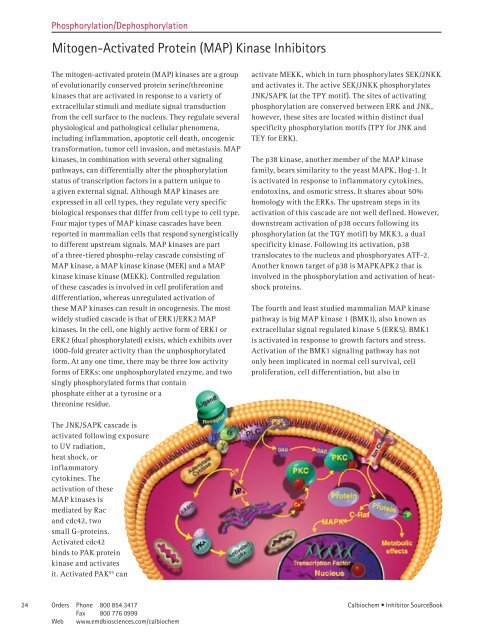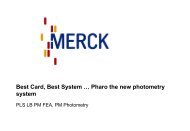Inhibitor SourceBook™ Second Edition
Inhibitor SourceBook™ Second Edition
Inhibitor SourceBook™ Second Edition
You also want an ePaper? Increase the reach of your titles
YUMPU automatically turns print PDFs into web optimized ePapers that Google loves.
Phosphorylation/Dephosphorylation<br />
Mitogen-Activated Protein (MAP) Kinase <strong>Inhibitor</strong>s<br />
The mitogen-activated protein (MAP) kinases are a group<br />
of evolutionarily conserved protein serine/threonine<br />
kinases that are activated in response to a variety of<br />
extracellular stimuli and mediate signal transduction<br />
from the cell surface to the nucleus. They regulate several<br />
physiological and pathological cellular phenomena,<br />
including inflammation, apoptotic cell death, oncogenic<br />
transformation, tumor cell invasion, and metastasis. MAP<br />
kinases, in combination with several other signaling<br />
pathways, can differentially alter the phosphorylation<br />
status of transcription factors in a pattern unique to<br />
a given external signal. Although MAP kinases are<br />
expressed in all cell types, they regulate very specific<br />
biological responses that differ from cell type to cell type.<br />
Four major types of MAP kinase cascades have been<br />
reported in mammalian cells that respond synergistically<br />
to different upstream signals. MAP kinases are part<br />
of a three-tiered phospho-relay cascade consisting of<br />
MAP kinase, a MAP kinase kinase (MEK) and a MAP<br />
kinase kinase kinase (MEKK). Controlled regulation<br />
of these cascades is involved in cell proliferation and<br />
differentiation, whereas unregulated activation of<br />
these MAP kinases can result in oncogenesis. The most<br />
widely studied cascade is that of ERK1/ERK2 MAP<br />
kinases. In the cell, one highly active form of ERK1 or<br />
ERK2 (dual phosphorylated) exists, which exhibits over<br />
1000-fold greater activity than the unphosphorylated<br />
form. At any one time, there may be three low activity<br />
forms of ERKs: one unphosphorylated enzyme, and two<br />
singly phosphorylated forms that contain<br />
phosphate either at a tyrosine or a<br />
threonine residue.<br />
The JNK/SAPK cascade is<br />
activated following exposure<br />
to UV radiation,<br />
heat shock, or<br />
inflammatory<br />
cytokines. The<br />
activation of these<br />
MAP kinases is<br />
mediated by Rac<br />
and cdc42, two<br />
small G-proteins.<br />
Activated cdc42<br />
binds to PAK protein<br />
kinase and activates<br />
it. Activated PAK 65 can<br />
activate MEKK, which in turn phosphorylates SEK/JNKK<br />
and activates it. The active SEK/JNKK phosphorylates<br />
JNK/SAPK (at the TPY motif). The sites of activating<br />
phosphorylation are conserved between ERK and JNK,<br />
however, these sites are located within distinct dual<br />
specificity phosphorylation motifs (TPY for JNK and<br />
TEY for ERK).<br />
The p38 kinase, another member of the MAP kinase<br />
family, bears similarity to the yeast MAPK, Hog-1. It<br />
is activated in response to inflammatory cytokines,<br />
endotoxins, and osmotic stress. It shares about 50%<br />
homology with the ERKs. The upstream steps in its<br />
activation of this cascade are not well defined. However,<br />
downstream activation of p38 occurs following its<br />
phosphorylation (at the TGY motif) by MKK3, a dual<br />
specificity kinase. Following its activation, p38<br />
translocates to the nucleus and phosphoryates ATF-2.<br />
Another known target of p38 is MAPKAPK2 that is<br />
involved in the phosphorylation and activation of heatshock<br />
proteins.<br />
The fourth and least studied mammalian MAP kinase<br />
pathway is big MAP kinase 1 (BMK1), also known as<br />
extracellular signal regulated kinase 5 (ERK5). BMK1<br />
is activated in response to growth factors and stress.<br />
Activation of the BMK1 signaling pathway has not<br />
only been implicated in normal cell survival, cell<br />
proliferation, cell differentiation, but also in<br />
24 Orders Phone 800 854 34 7<br />
Calbiochem • <strong>Inhibitor</strong> SourceBook<br />
Fax 800 776 0999<br />
Web www.emdbiosciences.com/calbiochem



